Draft Taxation Determination
TD 2017/D3
Income tax: Division 7A: can section 109T of the Income Tax Assessment Act 1936 apply to a payment or loan made by a private company to another entity (the 'first interposed entity') where that payment or loan is an ordinary commercial transaction?
-
Please note that the PDF version is the authorised version of this draft ruling.This document has been finalised by TD 2018/13.There is a Compendium for this document: TD 2018/13EC .
 This publication provides you with the following level of protection:
This publication provides you with the following level of protection:
This publication is a draft for public comment. It represents the Commissioner's preliminary view about the way in which a relevant taxation provision applies, or would apply to entities generally or to a class of entities in relation to a particular scheme or a class of schemes. You can rely on this publication (excluding appendixes) to provide you with protection from interest and penalties in the following way. If a statement turns out to be incorrect and you underpay your tax as a result, you will not have to pay a penalty. Nor will you have to pay interest on the underpayment provided you reasonably relied on the publication in good faith. However, even if you don't have to pay a penalty or interest, you will have to pay the correct amount of tax provided the time limits under the law allow it. |
Ruling
1. Yes. Section 109T of the Income Tax Assessment Act 1936 (ITAA 1936) can apply to a payment or loan made by a private company to another entity (the 'first interposed entity') where that payment or loan is an ordinary commercial transaction.
2. Where the Commissioner considers a reasonable person would conclude (having regard to all the circumstances) that the payment or loan to the first interposed entity is made solely or mainly as part of an arrangement involving a payment or loan to a shareholder or shareholder's associate (the 'target entity'), the target entity will be deemed to have been paid a dividend during the relevant year.[1]
All legislative references in this draft Determination are to the ITAA 1936.
Examples
3. In each of the following examples, section 109T applies to the respective ordinary commercial transactions entered into by Private Company A, Private Company C, Private Company D, Private Company E and Private Company G because the Commissioner considers a reasonable person would conclude (having regard to all the circumstances) that those private companies made their respective payments solely or mainly as part of an arrangement involving a payment or loan to the target entity and the payments made by those private companies are not excluded by subsection 109T(3).
4. As a result of section 109T applying, the Commissioner will determine the amount of the deemed payment under section 109V with Taxation Determination TD 2011/16 Income tax: Division 7A - payments and loans through interposed entities - factors the Commissioner will take into account in determining the amount of any deemed payment or notional loan arising under section 109T of the Income Tax Assessment Act 1936 (in particular paragraphs 46 and 47 of that Determination) setting out the factors the Commissioner will take into account in doing so.
5. This draft Determination does not consider the legal effectiveness of the arrangements described in the examples or the application of section 100A to those arrangements involving trusts. These considerations may alter the conclusion reached in a given case.
6. The type of arrangements set out in examples 4 and 5 in this draft Determination were the subject of Taxpayer Alert TA 2016/12 Trust income reduction arrangements. This draft Determination only considers those concerns in TA 2016/12 which relate to the application of section 109T. Other concerns may alter the conclusion reached in a given case.
Example 1
7. Private Company A has a significant distributable surplus including accumulated profits of $100,000.
8. Private Company A has two classes of shares with the Class A shares being held by Mr A and the Class B shares being held by Private Company B.
9. Private Company B has no distributable surplus.
10. Private Company A pays a fully franked dividend of $100,000 to Private Company B. On the same day, Private Company B uses that dividend to make an interest-free loan of $100,000 to Mr A.
11. Mr A does not repay the loan made by Company B by Private Company A's lodgment day for the year of income and it is not put on section 109N complying terms.
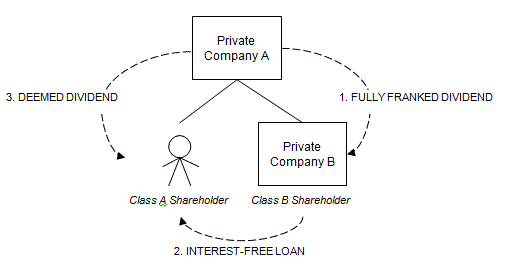
Example 2
12. Private Company C has a significant distributable surplus including accumulated profits of $100,000.
13. The S Family Trust is the sole shareholder of Private Company C.
14. Mr S is the sole director of Private Company C and is also the trustee of the S Family Trust.
15. The beneficiaries of the S Family Trust are Mr S and Mrs T who is a non-resident for income tax purposes.
16. Private Company C pays a fully franked dividend of $100,000 to the S Family Trust. On the same day, the S Family Trust uses that dividend to make an interest-free loan of $100,000 to Mr S.
17. On 30 June in the same year of income that the dividend was paid, the S Family Trust makes Mrs T presently entitled to 100% of the trust income being the fully franked dividend of $100,000.
18. Mr S does not repay the loan made by the S Family Trust by Private Company C's lodgment day for the year of income and is it not put on section 109N complying terms.
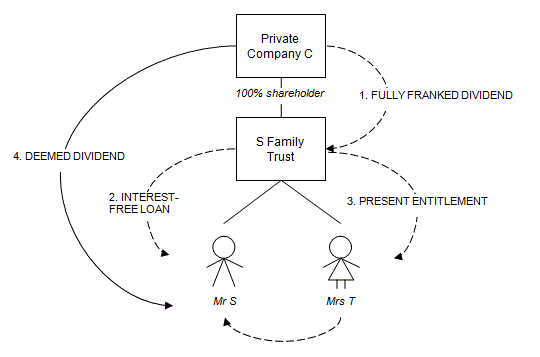
Example 3
19. Private Company D has a significant distributable surplus including accumulated profits of $100,000.
20. The H Family Trust is the sole shareholder of Private Company D.
21. Mrs H is the sole director of Private Company D and is also the trustee of the H Family Trust.
22. Mrs H is also a beneficiary of the H Family Trust and is the trustee of the H Unit Trust.
23. Private Company D subscribes for two units in the H Unit Trust and pays $50,000 for each unit. The H Unit Trust uses those funds to make an interest-free loan of $100,000 to Mrs H.
24. Mrs H does not repay the loan made by the H Unit Trust by Private Company D's lodgement day for the year of income and it is not put on section 109N complying terms.
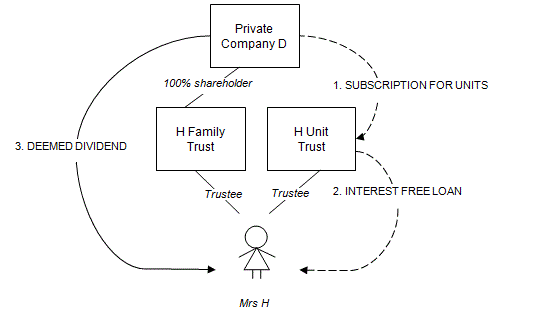
Example 4
25. Private Company E has a significant distributable surplus including accumulated profits of $1,000,000.
26. The W Family Trust is the sole shareholder of Private Company E.
27. Mr W is the sole director of Private Company E and is also the trustee of the W Family Trust.
28. The beneficiaries of the W Family Trust include Mr W and Private Company F.
29. Private Company E pays a fully franked dividend of $1,000,000 to the W Family Trust and the W Family Trust uses $950,000 of that dividend to acquire a residential property. Prior to the end of the year of income, Mr W, as trustee for the W Family Trust, transfers the residential property to Mr W as an in-specie capital distribution.
30. Mr W cites a clause in the W Family Trust's deed to support a determination that the in-specie distribution causes a $950,000 loss in the trust that is to be made good out of income in the year of income in which the distribution is made and that the trust income is $50,000 for the year of income.
31. Mr W also resolves to make Private Company F presently entitled to all of the trust income of $50,000 and treats the transfer of the residential property as a tax-free distribution.
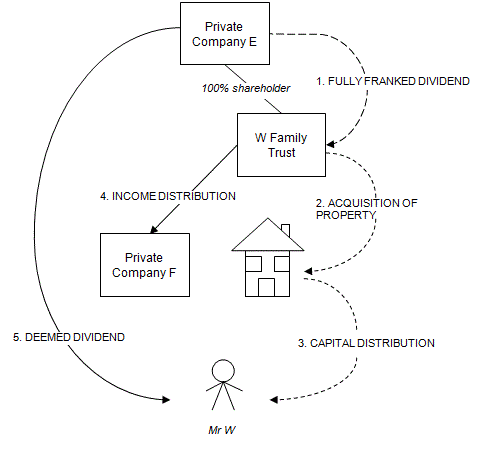
Note: Whether or not a particular trust deed gives a trustee power to make a determination in the manner described would depend on a proper analysis of the deed in the context of a particular case.
Example 5
32. Private Company G has a significant distributable surplus including accumulated profits of $1,000,000.
33. The M Family Trust is the sole shareholder in Private Company G.
34. Mrs M is the sole director of Private Company G and is also the trustee of the M Family Trust.
35. The beneficiaries of the M Family Trust include Mrs M and Private Company H.
36. In the 2015-16 year of income, Mrs M, as trustee of the M Family Trust, re-values, in the trust accounts, the ordinary shares of Private Company G from a par value of $2 to $1,000,002 in recognition of Private Company G's accumulated profits.
37. In the same year of income, Mrs M, as trustee of the M Family Trust, purportedly in accordance with the terms of the trust deed, creates a $1,000,000 capital entitlement from the asset revaluation reserve in favour of Mrs M. The entitlement is not paid during the year of income.
38. In the 2016-17 year of income, the M Family Trust receives a fully franked dividend from Private Company G of $1,000,000 and other interest income of $1,000.
39. In the trust accounts for the 2016-17 year of income, Mrs M, as trustee of the M Family Trust, records the dividend and interest as income and reduces the value of the shares in Private Company G to $2 (resulting in a $1,000,000 loss), to reflect the now reduced accumulated profits. Purportedly, in accordance with the trust deed, Mrs M, as trustee of the M Family Trust makes good the $1,000,000 loss out of income in the trust accounts and determines that the trust income of the M Family Trust for the 2016-17 year of income is $1,000.
40. The net income of the M Family Trust for the 2016-17 year of income is $1,429,571 (being the total of the interest, the dividends and the franking credit amount).
41. Mrs M, as trustee for the M Family Trust, resolves to make Private Company H presently entitled to all of the trust income of the M Family Trust of $1,000. As a result, the whole amount of the net income of the M Family Trust, being $1,429,571, is included in Private Company H's assessable income for the 2016-17 year of income.
42. However, because Private Company H is entitled to the franking credit offset, it is only liable to pay tax on the amount of the interest.
43. Mrs M, as trustee of the M Family Trust, uses the $1,000,000 dividend to satisfy Mrs M's $1,000,000 capital entitlement created in the 2015-16 year or income and Mrs M treats the amount as a tax-free distribution.
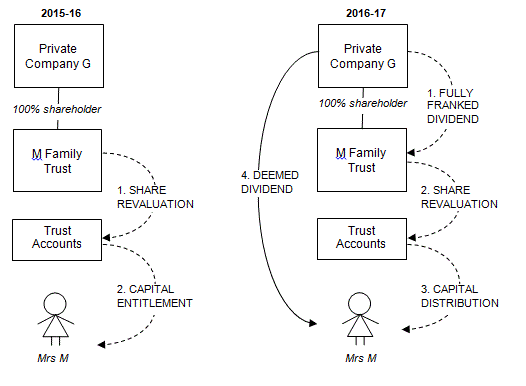
Note: Whether or not a particular trust deed gives a trustee power to make a determination in the manner described would depend on a proper analysis of the deed in the context of a particular case.
Date of effect
44. When the final Determination is issued, it is proposed to apply both before and after its date of issue. However, the Determination will not apply to taxpayers to the extent that it conflicts with the terms of settlement of a dispute agreed to before the date of issue of the Determination (see paragraphs 75 to 76 of Taxation Ruling TR 2006/10).
Commissioner of Taxation
28 June 2017
Appendix 1 - Explanation
 This Appendix is provided as information to help you understand how the Commissioner's preliminary view has been reached. It does not form part of the proposed binding public ruling.
This Appendix is provided as information to help you understand how the Commissioner's preliminary view has been reached. It does not form part of the proposed binding public ruling.
|
45. This Determination should be read in conjunction with Taxation Determination TD 2012/12 Income tax: Division 7A: do the rules in Subdivision D of Division 7A of Part III of the Income Tax Assessment Act 1936 which exclude certain payments or loans from being treated as dividends under Subdivision B of Division 7A of that Act necessarily affect the circumstances in which a deemed payment or notional loan arises under Subdivision E of Division 7A of that Act?. As stated in paragraph 18 of that Determination, the fact that an arrangement may not have been entered into for the purpose of circumventing Division 7A is not relevant to the application of section 109T.
Division 7A generally
46. Division 7A is a specific integrity Division designed to ensure that private companies cannot make disguised or informal distributions of profits to a shareholder or a shareholder's associate in the form of payments, loans or forgiven debts. The Explanatory Memorandum to the Taxation Laws Amendment Bill (No. 7) 1997 makes it clear that Division 7A is intended to have broad application and its application is limited only to the extent of specific exceptions and exclusions.[2]
47. Generally, where a private company makes a payment or loan to a shareholder or a shareholder's associate, subject to the amount of the private company's distributable surplus, under Division 7A, the private company is taken to have paid a dividend to the shareholder or the shareholder's associate. As a result, the amount is included in the assessable income of the shareholder or the shareholder's associate under section 44.
The interposed entity rules
48. Where a private company makes a payment or loan to an entity interposed (the 'first interposed entity') between the private company and another entity (the 'target entity') and that first interposed entity, or another interposed entity between the private company and the target entity, makes a payment or loan to the target entity under an arrangement involving the private company, Subdivision E of Division 7A may operate to deem the private company to be taken to make a payment or loan to the target entity (to which Subdivision B of Division 7A may then operate).
49. In particular, subsection 109T(1) provides that a private company will be taken to make a payment or loan to the target entity where a reasonable person would conclude (having regard to all the circumstances) that the private company made the payment or loan to the first interposed entity, solely or mainly, as part of an arrangement involving a payment or loan through one or more interposed entities to the target entity.
50. If the outcome of the arrangement is that the target entity would effectively receive a tax-free distribution from the private company (but for the application of Subdivision E of Division 7A), the arrangement properly falls for consideration under Subdivision E of Division 7A (subject to the application of subsection 109T(3)). This would be so regardless of the intention of the parties to the arrangement, given the intended purpose of Division 7A.[3]
51. However, if a payment or loan made by a private company to the first interposed entity itself results in Division 7A treating the amount as a dividend to the first interposed entity, Subdivision E of Division 7A does not apply to the payment or loan made by the interposed entity.[4] Further, and importantly, a transaction which itself results in Division 7A treating the amount as a dividend to the first interposed entity is the only kind of transaction, between the private company and the first interposed entity to which subsection 109T(1) cannot apply.
52. Subject to that exclusion, the Commissioner must consider whether the reasonable person test in paragraph 109T(1)(b) is satisfied for every arrangement involving a payment or loan made by a private company to a first interposed entity (regardless of the nature of the payment or loan). The fact that the payment or loan may be considered to be an ordinary commercial transaction does not, of itself, exclude the operation of section 109T.
53. Further, even if all, or some, of the amount of the payment made by the private company is included in the first interposed entity's assessable income, this does not preclude subsection 109T(1) from applying such that a private company will be taken to have made a payment or loan to the target entity.[5]
Dividends assessable under section 44 apart from the operation of Division 7A
54. Where a private company makes a payment to the first interposed entity that is a section 44 dividend[6], it is not a payment which results in Division 7A deeming a dividend to the first interposed entity.[7] Therefore, the exclusion in subsection 109T(3) does not apply to that payment.
55. Accordingly, a section 44 dividend is a payment to which subsection 109T(1) can apply in terms of a broader arrangement involving a payment or loan made to a target entity.
56. If a reasonable person would conclude (having regard to all the circumstances) that the private company made the payment of the section 44 dividend to the first interposed entity solely or mainly as part of an arrangement involving a payment or loan to the target entity, neither of the following factors prevents Subdivision E of Division 7A from applying:
- (a)
- that the payment of the section 44 dividend is an ordinary commercial transaction, or
- (b)
- that all, or some, of the amount of the payment of the section 44 dividend is included in the first interposed entity's assessable income.
57. Importantly, subsection 109X(1) expressly provides that Subdivision E of Division 7A may still apply even if the amount paid by the private company to the first interposed entity is included in assessable income of the first interposed entity.
58. If subsection 109T(1) could never apply where the payment from a private company to the first interposed entity was a section 44 dividend, the application of Division 7A could be overcome by interposing a private company with no distributable surplus in an arrangement involving a payment or loan from the interposed private company to the target entity.
59. Subdivision E of Division 7A targets arrangements which would not otherwise be captured by Division 7A (for example, the application of sections 109C or 109D) because of the interposition of an entity or entities between the private company and target entity. The view that the rules in Subdivision E of Division 7A can apply where the nature of the transaction between the private company and first interposed entity is a section 44 dividend accords with that purpose. It also aligns with the language and structure of Subdivision E of Division 7A, including that subsection 109T(3) only applies if a payment or loan made by a private company to the first interposed entity itself results in Division 7A treating the amount as a dividend to the first interposed entity.
Other ordinary commercial transactions that do not involve dividends assessable under section 44 apart from the operation of Division 7A
60. Similarly, any other kind of payment or loan that is an ordinary commercial transaction, or included in the interposed entity's assessable income, could be a payment or loan to which the interposed entity rules apply if (taking into consideration all of the circumstances) a reasonable person would conclude that the payment or loan by the private company was made solely or mainly as part of an arrangement involving the payment or loan to the target entity.
61. If subsection 109T(1) did not apply where the payment or loan from the private company to the first interposed entity was a transaction ordinarily seen in commercial dealings, the application of Division 7A could also be overcome by the private company subscribing for an equity interest in another entity (for example, units in a unit trust or an interest in a partnership) as part of an arrangement involving a payment or loan from an interposed entity to the target entity.
62. As with section 44 dividends, there is nothing about the nature of any other ordinary commercial transaction which supports an interpretation of section 109T that would limit its application. For example, neither a loan from the private company to another company (being the first interposed entity), nor a payment which discharges a pecuniary obligation by the private company to the first interposed entity, would (by their nature) exclude the operation of section 109T. The former is made clear by subsection 109X(1) and, as is explained in Taxation Determination TD 2012/12, the latter is a factor which may be taken into account in setting the amount of the notional payment or loan under sections 109V and 109W respectively.
Amount of the payment or loan taken to have been made by the private company to the target entity
63. Where section 109T applies, the amount of the payment or loan taken to have been made by the private company to the target entity is determined by the Commissioner taking into account the factors described in sections 109V and 109W respectively.[8]
64. In addition to the other relevant factors described in TD 2011/16, the Commissioner may, in appropriate cases, consider (having regard to the intended purpose of Division 7A) the extent to which tax is otherwise payable because of the structure used in the arrangement.
Appendix 2 - Your comments
65. You are invited to comment on this draft Determination including the proposed date of effect. Please forward your comments to the contact officer by the due date.
66. A compendium of comments is prepared for the consideration of the relevant Rulings Panel or relevant tax officers. An edited version (names and identifying information removed) of the compendium of comments will also be prepared to:
- •
- provide responses to persons providing comments, and
- •
- be published on the ATO website at www.ato.gov.au
Please advise if you do not want your comments included in the edited version of the compendium.
| Due date: | 26 July 2017 |
| Contact officer details have been removed following publication of the final determination. | |
© AUSTRALIAN TAXATION OFFICE FOR THE COMMONWEALTH OF AUSTRALIA
You are free to copy, adapt, modify, transmit and distribute this material as you wish (but not in any way that suggests the ATO or the Commonwealth endorses you or any of your services or products).
Footnotes
However, section 109T does not apply if the payment or loan to the first interposed entity, itself, gives rise to a deemed dividend (subsection 109T(3)).
See paragraphs 9.1 and 9.2 of the Explanatory Memorandum to the Taxation Laws Amendment Bill (No. 7) 1997.
The Commissioner does not consider that the distribution has to be tax-free, or entirely tax-free, for the reasonable person test to be satisfied but being tax-free strongly supports the relevant conclusion being drawn.
Subsection 109T(3).
Paragraph 109X(1)(b).
A dividend which would, apart from the operation of Division 7A, be included in an entity's assessable income under section 44.
Subsection 109L(1).
TD 2011/16 sets out some of the factors the Commissioner will take into account in determining the amount of any deemed payment or notional loan arising under section 109T.
Not previously issued as a draft
References
ATO references:
NO 1-AKGDB8Q
Related Rulings/Determinations:
TR 2006/10
TD 2001/2
TD 2011/16
TD 2012/12
Legislative References:
ITAA 1936
ITAA 1936 44
ITAA 1936 100A
ITAA 1936 Div 7A
ITAA 1936 Pt III Div 7A Subdiv B
ITAA 1936 Pt III Div 7A Subdiv D
ITAA 1936 Pt III Div 7A Subdiv E
ITAA 1936 109C
ITAA 1936 109D
ITAA 1936 109L(1)
ITAA 1936 109N
ITAA 1936 109T
ITAA 1936 109T(1)
ITAA 1936 109T(1)(b)
ITAA 1936 109T(3)
ITAA 1936 109V
ITAA 1936 109W
ITAA 1936 109X(1)
ITAA 1936 109X(1)(b)
Other References:
TA 2016/12
Explanatory Memorandum to the Tax Laws Amendment Bill (No. 7) 1997
